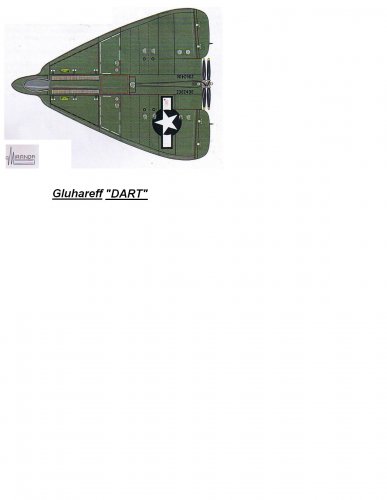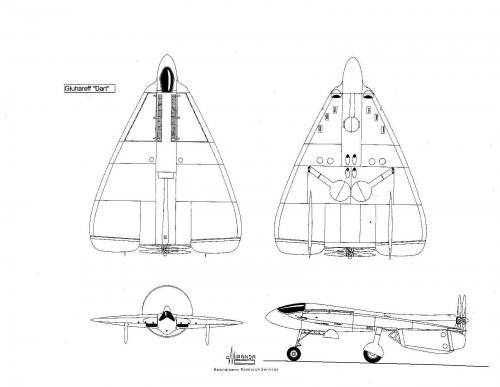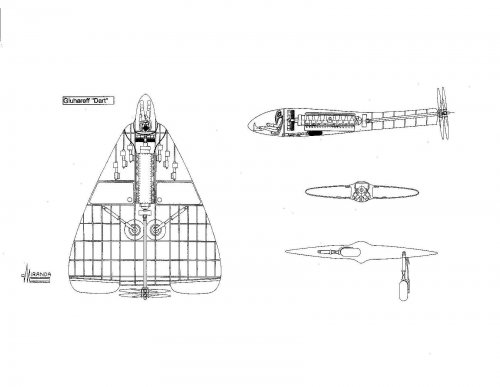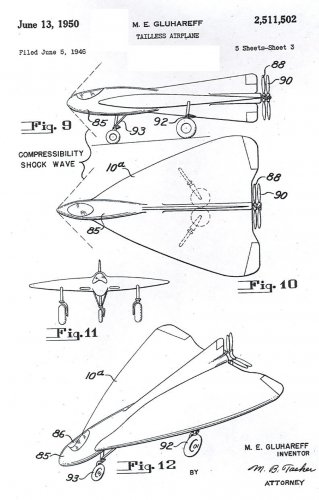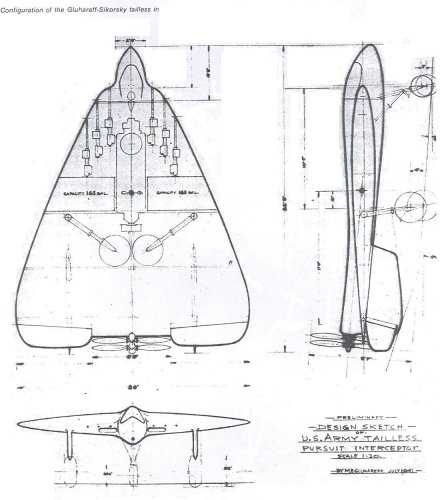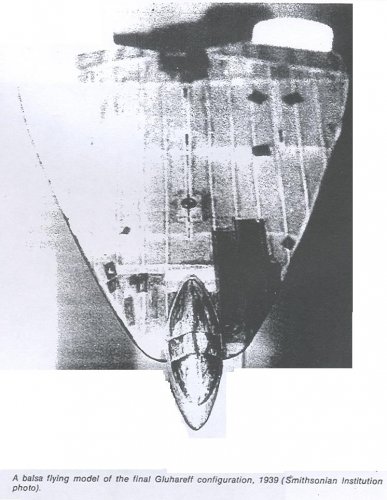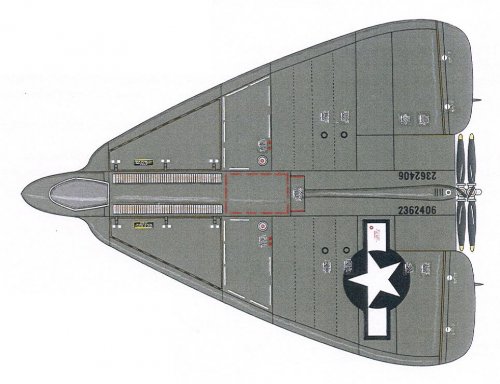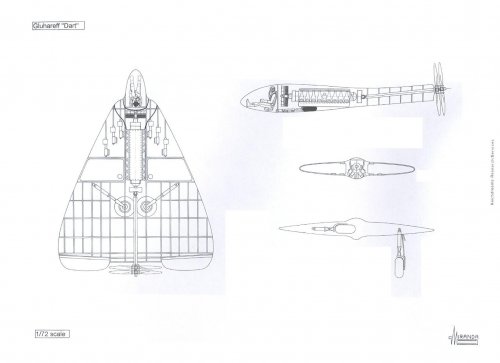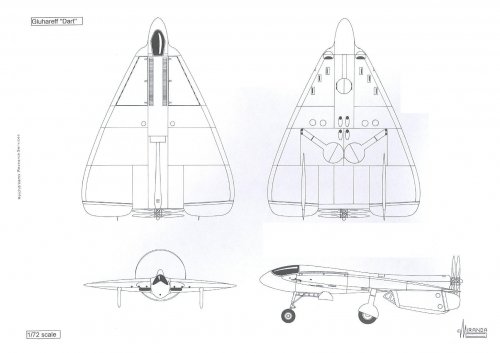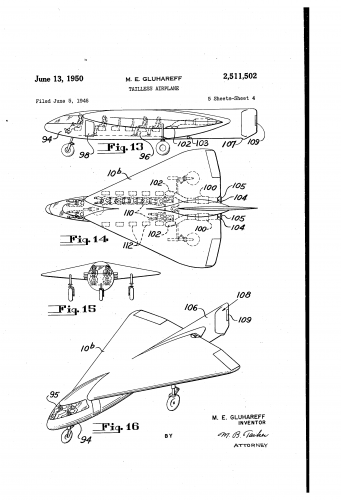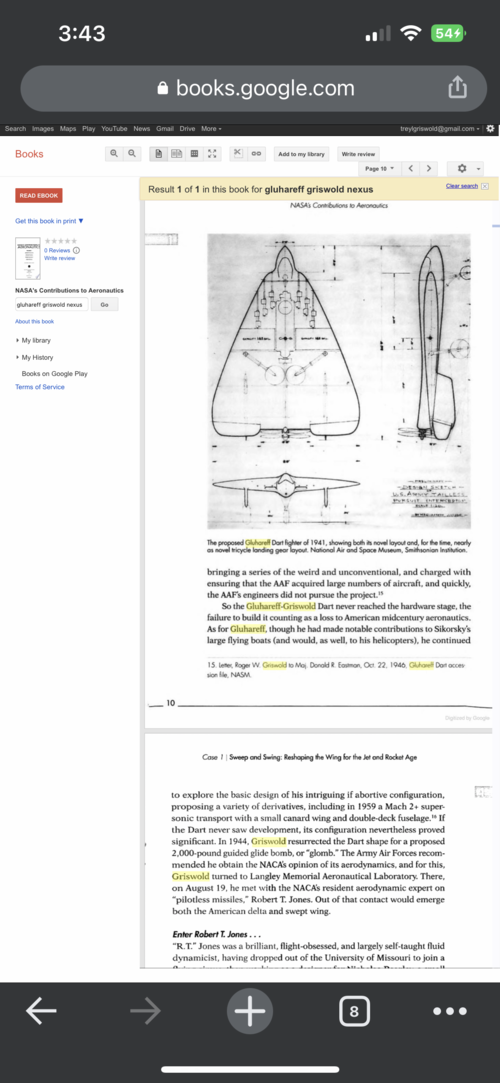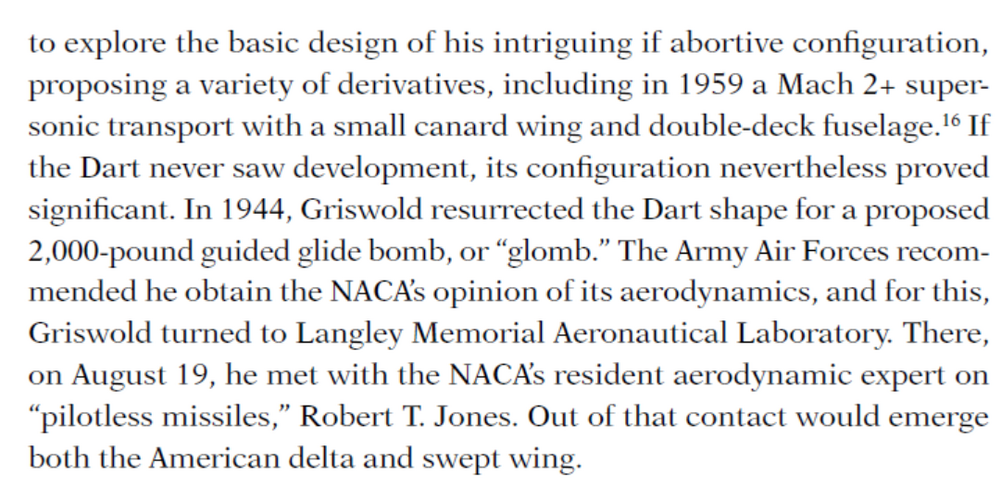You are using an out of date browser. It may not display this or other websites correctly.
You should upgrade or use an alternative browser.
You should upgrade or use an alternative browser.
Gluhareff-Sikorsky "Dart"
- Thread starter hesham
- Start date
Tophe
ACCESS: Top Secret
The Gluhareff Dart's 3-view is in the booklet "Unknown No.3", sold at http://www.luft46.com/rd/rdreams.htmlhesham said:My dears,
I heard that Gluhareff was designed a several delta wing fighters
to USAF and NACA,can anybody confirm that information ?.
(view from below on the cover in that site)
- Joined
- 22 January 2006
- Messages
- 4,213
- Reaction score
- 2,010
Unknown No.3
Anybody can post a pic of the Gluhareff fighter?. Who's Mr Gluhareff?.
Anybody can post a pic of the Jet Thunderbolt project?
Thanks a lot
Dear friend,
The Gluhareff fighter is illustrated in the WaffenArsenal band 102 on page 42.
(German version)
'Überschalljäger Lippisch P13a und Versuchsgleiter DM-1'
Michael Gluhareff was a Russian engineer who fled via Finland to the U.S in 1924.
He worked for Igor Sikorsky and became chief of design for Vought-Sikorsky in 1935.
His work on tailless aircraft designs "arrow tip" as he called it is described in
"Lippisch,Gluhareff and Jones: The emergence of the Delta Planform
and the Origins of the Swept Wing in the United States" by Richard P.Hallion.
in Aerospace Historian of March 1979.
The Gluhareff fighter is illustrated in the WaffenArsenal band 102 on page 42.
(German version)
'Überschalljäger Lippisch P13a und Versuchsgleiter DM-1'
Michael Gluhareff was a Russian engineer who fled via Finland to the U.S in 1924.
He worked for Igor Sikorsky and became chief of design for Vought-Sikorsky in 1935.
His work on tailless aircraft designs "arrow tip" as he called it is described in
"Lippisch,Gluhareff and Jones: The emergence of the Delta Planform
and the Origins of the Swept Wing in the United States" by Richard P.Hallion.
in Aerospace Historian of March 1979.
ChuckAnderson
ACCESS: Confidential
- Joined
- 10 May 2006
- Messages
- 188
- Reaction score
- 45
pometablava said:Unknown No.3
Anybody can post a pic of the Gluhareff fighter?. Who's Mr Gluhareff?.
Anybody can post a pic of the Jet Thunderbolt project?
Thanks a lot
Hi pometeblava!
As always, I hope this posting works!
Here is a top view (in colour) of the Gluhareff Dart.
SOURCE: UNKNOWN! (3)
J. Miranda & P. Mercado
Illustration by J. Miranda
Chuck
Attachments
ChuckAnderson
ACCESS: Confidential
- Joined
- 10 May 2006
- Messages
- 188
- Reaction score
- 45
ChuckAnderson
ACCESS: Confidential
- Joined
- 10 May 2006
- Messages
- 188
- Reaction score
- 45
- Joined
- 14 June 2006
- Messages
- 2,300
- Reaction score
- 561
Just to point to some later Gluhareff work... 
http://www.google.com/patents?vid=USPATD187349&id=rwB0AAAAEBAJ&jtp=1#PPP1,M1
http://www.google.com/patents?vid=USPATD187349&id=rwB0AAAAEBAJ&jtp=1#PPP1,M1
Please see attached some stuff from
-Aerospace Historian , march 1979
-Patent No 2.511.502
And three speculative drawings by myself
Wingspan 20' , Lenght 26'6" , Engine 2500 hp Chrysler XIV-2220
SOURCE GRADING 4
See also http://www.secretprojects.co.uk/forum/index.php/topic,183.15.html
-Aerospace Historian , march 1979
-Patent No 2.511.502
And three speculative drawings by myself
Wingspan 20' , Lenght 26'6" , Engine 2500 hp Chrysler XIV-2220
SOURCE GRADING 4
See also http://www.secretprojects.co.uk/forum/index.php/topic,183.15.html
Attachments
My Grandfather spent his whole life from 19 years old to retirement working on aircraft and mainly with Sikorsky.
He won every award possible from the 1920's until 1960's..also my Great Uncle Serge worked at Sikorsky as well as my Father Alex and Uncle Eugene Gluhareff.
I am in the process of doing a website dedicated to grandfathers life work, showing pictures, awards and several of his drawings.
it will be located at www.sikorsky.ws
this will be avail for all to view in a couple weeks.
thanks
Betsy Gluhareff
He won every award possible from the 1920's until 1960's..also my Great Uncle Serge worked at Sikorsky as well as my Father Alex and Uncle Eugene Gluhareff.
I am in the process of doing a website dedicated to grandfathers life work, showing pictures, awards and several of his drawings.
it will be located at www.sikorsky.ws
this will be avail for all to view in a couple weeks.
thanks
Betsy Gluhareff
Hi guys,
My Grandfathers website is up and running with pictures, drawings and a small bio.
I will be adding more drawings and prints as I recieve them from the old archives and files.
The people at Sikorksy will be donating some photos and drawings from their files this week also.
PLEASE sign the guest book so I know Grandfathers friends remember him and visited the site.
if ANYONE has a pic or drawing or info they would like to add to the site PLEASE contact me asap.
[link dead - Admin] www.sikorsky.ws
Betsy Gluhareff
My Grandfathers website is up and running with pictures, drawings and a small bio.
I will be adding more drawings and prints as I recieve them from the old archives and files.
The people at Sikorksy will be donating some photos and drawings from their files this week also.
PLEASE sign the guest book so I know Grandfathers friends remember him and visited the site.
if ANYONE has a pic or drawing or info they would like to add to the site PLEASE contact me asap.
[link dead - Admin] www.sikorsky.ws
Betsy Gluhareff
Some of you remember Micheal Gluhareff the Russian inventor who helped build Sikorksy into a world leader and was a major force in the first working helicopter...Invented "The Dart" ect....
if you do please help pay respects by visiting the new website dedicated to his memory at
www.sikorsky.ws and sign the guest book
Thanks
Betsy Gluhareff
if you do please help pay respects by visiting the new website dedicated to his memory at
www.sikorsky.ws and sign the guest book
Thanks
Betsy Gluhareff
lippischh
ACCESS: Secret
just found this link accidentally, i dunno if you guys are familiar with it, its called “Dart” Gluhareff configuration
http://alternathistory.org.ua/dart-gluhareff-neveroyatnyi-istrebitel-mikhaila-glukhareva-proekt-ssha-1937-39g
http://alternathistory.org.ua/dart-gluhareff-neveroyatnyi-istrebitel-mikhaila-glukhareva-proekt-ssha-1937-39g
W
Wingknut
Guest
Found this at: http://www.airpages.ru/dc/german_influence.shtml
http://www.airpages.ru/dc/german_influence_03s.jpg
I stress the title ‘german influence’ is not mine but anyway, the caption text (as rendered via Google translate) runs thus:
“1. Schematic of the experimental aircraft "Arrow" design A. Moskalev, built and tested in 1937, "Arrow" was to design an aerodynamic analogue Moskalev fighter "Sigma".
2. Draft a fighter-interceptor, developed on the company Sikorski M. Glukhareva [Gluhareff] in 1939-1941.
3. Scheme of LP-13 fighter, 1945
4. missile destroyer Scheme K-15 KA Kalinin, 1937
5. Scheme BI aircraft Cheranovskii, 1944”
I'm not sure how accurate that caption is of course.
http://www.airpages.ru/dc/german_influence_03s.jpg
I stress the title ‘german influence’ is not mine but anyway, the caption text (as rendered via Google translate) runs thus:
“1. Schematic of the experimental aircraft "Arrow" design A. Moskalev, built and tested in 1937, "Arrow" was to design an aerodynamic analogue Moskalev fighter "Sigma".
2. Draft a fighter-interceptor, developed on the company Sikorski M. Glukhareva [Gluhareff] in 1939-1941.
3. Scheme of LP-13 fighter, 1945
4. missile destroyer Scheme K-15 KA Kalinin, 1937
5. Scheme BI aircraft Cheranovskii, 1944”
I'm not sure how accurate that caption is of course.
Attachments
KHambsch
ACCESS: Confidential
- Joined
- 11 May 2020
- Messages
- 180
- Reaction score
- 189
Thank you for those Chuck! Gene was a thoughtful engineer...can see fluid dynamics thinking in what he came up with. KevinHi!
Here's another illustration of the Gluhareff Dart from the same source.
Chuck
KHambsch
ACCESS: Confidential
- Joined
- 11 May 2020
- Messages
- 180
- Reaction score
- 189
I am able to contact his granddaughter Irena. She was hoping to reignite (pardon the expression) the tip-jet 20 lb. pressure jet engine with a new design, but I'm pretty sure there wasn't enough interest in it to keep things alive. I've spoken with a few people who knew Gene...shame I didn't get the chance. Kevin HambschWhat a shame! Any news as to what the Gluhareff/Sikorsky website has become? Does anyone still have contact with the family?
KHambsch
ACCESS: Confidential
- Joined
- 11 May 2020
- Messages
- 180
- Reaction score
- 189
Hi Hesham, More on Gluhareff Dart or Pressure Jet engine? I found Justo's description to be quite detail. Re the pressure jet engine, it was designed for the cord-end-tip of the main rotor(s) for helicopters. I have an online (axial) version that I designed...wool be putting it in the propulsion section soon.Hi KHambsch,
if you can get this,please we want to see,and if there is anther
Projects or drawings,we would like that.
Regards, Kevin Hambsch
Nik
ACCESS: Top Secret
- Joined
- 15 July 2009
- Messages
- 1,269
- Reaction score
- 1,062
Thank you for these. Tricycle configuration, so very neat. Lots of pilot visibility ?
Hopefully, the under-wing 'tails' were reinforced with skids against 'Rotation' oopsies, per similar ventral pads on modern passenger aircraft...
That lonnnng driveshaft may have proved problematic, engine access 'interesting'...
Um, did they consider pilot escape, given those 'mixmaster' blades lurking ??
Hopefully, the under-wing 'tails' were reinforced with skids against 'Rotation' oopsies, per similar ventral pads on modern passenger aircraft...
That lonnnng driveshaft may have proved problematic, engine access 'interesting'...
Um, did they consider pilot escape, given those 'mixmaster' blades lurking ??
My great grandfather Roger W Griswold II worked with your grandfather on this project. So crazy to be discovering this on the internet and finding these forums. Attached is an excerpt from a book on NASA’s contributions to aeronautics.My Grandfather spent his whole life from 19 years old to retirement working on aircraft and mainly with Sikorsky.
He won every award possible from the 1920's until 1960's..also my Great Uncle Serge worked at Sikorsky as well as my Father Alex and Uncle Eugene Gluhareff.
I am in the process of doing a website dedicated to grandfathers life work, showing pictures, awards and several of his drawings.
it will be located at www.sikorsky.ws
this will be avail for all to view in a couple weeks.
thanks
Betsy Gluhareff
Attachments
Both volumes of the NASA book are available as free downloads from NASA:My great grandfather Roger W Griswold II worked with your grandfather on this project. So crazy to be discovering this on the internet and finding these forums. Attached is an excerpt from a book on NASA’s contributions to aeronautics.My Grandfather spent his whole life from 19 years old to retirement working on aircraft and mainly with Sikorsky.
He won every award possible from the 1920's until 1960's..also my Great Uncle Serge worked at Sikorsky as well as my Father Alex and Uncle Eugene Gluhareff.
I am in the process of doing a website dedicated to grandfathers life work, showing pictures, awards and several of his drawings.
it will be located at www.sikorsky.ws
this will be avail for all to view in a couple weeks.
thanks
Betsy Gluhareff

NASA's Contributions to Aeronautics, Volume 1
This first volume in a two-volume set includes case studies and essays on NACA-NASA research for contributions such as high-speed wing design, the area rule, rotary-wing aerodynamics research, sonic boom mitigation, hypersonic design, computational fluid dynamics, electronic flight control and...
- Joined
- 26 May 2006
- Messages
- 34,897
- Reaction score
- 15,759
My great grandfather Roger W Griswold II worked with your grandfather on this project. So crazy to be discovering this on the internet and finding these forums. Attached is an excerpt from a book on NASA’s contributions to aeronautics.My Grandfather spent his whole life from 19 years old to retirement working on aircraft and mainly with Sikorsky.
He won every award possible from the 1920's until 1960's..also my Great Uncle Serge worked at Sikorsky as well as my Father Alex and Uncle Eugene Gluhareff.
I am in the process of doing a website dedicated to grandfathers life work, showing pictures, awards and several of his drawings.
it will be located at www.sikorsky.ws
this will be avail for all to view in a couple weeks.
thanks
Betsy Gluhareff
Nice Info,and welcome aboard Tgris.
Jerry O'Neill
ACCESS: Restricted
- Joined
- 3 November 2024
- Messages
- 1
- Reaction score
- 2
Hello Betsy,Hi guys,
My Grandfathers website is up and running with pictures, drawings and a small bio.
I will be adding more drawings and prints as I recieve them from the old archives and files.
The people at Sikorksy will be donating some photos and drawings from their files this week also.
PLEASE sign the guest book so I know Grandfathers friends remember him and visited the site.
if ANYONE has a pic or drawing or info they would like to add to the site PLEASE contact me asap.
[link dead - Admin] www.sikorsky.ws
Betsy Gluhareff
I am very interested in your grandfather's work. I am currently Vice President of the Connecticut Air & Space Center in Stratford, CT and I think our curator would be very interested in his story.
Please take a look at our website: www.ctairandspace.org
Thank you.
Jerry O'Neill
VP - Connecticut Air & Space Center
Stratford, CT
Gluhareff Dart
The chief of design for the Vought-Sikorsky Aircraft Division of United Aircraft Corporation Michael Gluhareff, made several theoretical studies on the delta wing between 1936 and 1939, building a series of balsa flying models. In July 1941, he proposed to Igor Sikorsky the building of a low-aspect ratio tailless fighter with an ogival delta wing and a sweepback angle of 56 degrees.
The airplane concept was around the future XIV-2220 engine which design and building had been ordered by the US Army Air Force to the Chrysler Company by the beginning of 1941. It was a monstrous power plant with a length of 3.175 m and 2500 hp. formed by two V8 in tandem engines with a combined capacity of 36.38 lt.
Gluhareff estimated that the XIV-2220 was ideal for a very fast pusher fighter with a minimum frontal section, for better weight balance, the engine should be installed in front of the main landing gear, requiring the use of a drive shaft of 2.88 m for the pusher contra-rotating airscrews.
The cooling air intakes were in the wing roots, under the machine guns. The radiator was located behind the pilot and had an auxiliary fan connected to the engine.
For roll and pitch control the wings had elevons (named flippers at the time). The directional control was obtained by conventional rudders mounted on two ventral fins.
The aircraft did not employ flaps, slots or spoilers.
In September 1942, when the heavy fighters P-38 and P-47 started experiencing problems of compressibility buffeting, it was thought that the delta wing could be used to delay the appearance of the undesired transonic phenomenon beyond 0.85 Mach.
Gluhareff ordered the building of a wind tunnel model to the Ludington-Griswold Inc. and the aerodynamic testing, finished in November 1942, looked very promising.
The design, named Dart was presented to the US Army Air Force for testing in the Aircraft Laboratory and Aircraft Projects Section at Wright Field.
Several reasons influenced the decision of not manufacturing the Dart. The compressibility buffeting problems were solved with the installation of an electric flap under the wings of the P-38 and P-47 and the ban on making certain combat maneuvers.
The XIV-2220 engine was not ready for testing until 1945 and the centrifugal turbojets of the time were too bulky for the available room in the small fighter.
Additionally, the pilots were reluctant to fly in the pusher types airplanes (XP-54, XP-55 and XP-56) due to the hazard of being hit by the propellers in case of bail out and the natural resistance of engineers to incorporate too many novelties in a single design.
On 26 May 1944 the USAAF received a proposal to transform the project in a glider bomb of 906 kg.
The Dart design was patented for civil use after the war.
Gluhareff Dart technical data
Engine: one 2,500 hp Chrysler XIV-2220-11, 16 cylinder, inverted ‘V’, liquid-cooled engine driving a four-bladed contra-rotating airscrew.
Wingspan: 20 ft. (6,096 m), length: 26.5 ft. (8.077 m), height: 6.5 ft. (1.98 m), wing area: 278 sq. ft. (25 sq. m), estimated maximum weight: 6,623 lbs. (3,000 kg), estimated top speed: 500 mph (805 kph), estimated range: 1,120 mls (1,802 kph).
- Joined
- 11 March 2012
- Messages
- 3,249
- Reaction score
- 3,179
Those low aspect-ratio deltas looked great on paper back when engineers only knew how to calculate 2 dimensional air flow.
They are fine in cruise and high-speed flight, with shallow angles-of-attack.
But as soon as you transition to high angles-of-attack, then air flow changes radically.
The delta ceases acting like a conventional wing and becomes a pair of huge wing-tips. The entire leading-edge starts acting like giant wing tips, generating massive wing-tip vortices. Those vortices generate lift but they also generate loads of drag.
See the work of Withold Kasper.
They are fine in cruise and high-speed flight, with shallow angles-of-attack.
But as soon as you transition to high angles-of-attack, then air flow changes radically.
The delta ceases acting like a conventional wing and becomes a pair of huge wing-tips. The entire leading-edge starts acting like giant wing tips, generating massive wing-tip vortices. Those vortices generate lift but they also generate loads of drag.
See the work of Withold Kasper.
Similar threads
-
-
“The Ultimate Allied Fighters of the Second World War” by Justo Miranda
- Started by Justo Miranda
- Replies: 40
-
-
Eugene Gluhareff Helicopters & Projects
- Started by hesham
- Replies: 10
-

